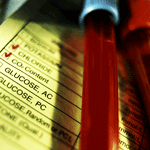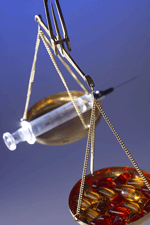
Gay women could be at greater risk than heterosexual females of suffering from Polycystic Ovarian Syndrome (PCOS), the potentially dangerous hormone imbalance linked to Insulin Resistance.
Obesity caused by the Insulin Resistance symptoms of high blood glucose and high insulin levels can lead to PCOS. Polycystic Ovarian Syndrome can also expose sufferers to a higher likelihood of developing Pre- and Type 2 Diabetes, as well as the cluster of increased risks for cardiovascular disease called Metabolic Syndrome (Syndrome X).
A 2004 study presented at the 19th European Society of Human Reproduction and Embryology conference showed that a large majority of lesbians seeking fertility treatment at a London clinic suffered either solely from polycystic ovaries (ovaries with attached, fluid-filled cysts or sacs) or from the multiple symptoms of full-blown PCOS, ranging from ovarian cysts to external manifestations like acne and excess facial hair.1
Dr. Rina Agrawal, deputy medical director at the London Women’s Clinic, examined 618 women who attended the clinic for fertility treatments between November 2001 and January 2003. Of these, 254 were lesbian and 364 were heterosexual.
The women did not know they had Polycystic Ovarian Syndrome before attending the clinic. But 15 percent had been treated previously for symptoms relating to PCOS, such as irregular periods, inability to conceive, and excessive body or facial hair.
 The women had a pelvic ultrasound examination on the second or third day of their menstrual cycle, and blood samples were taken to measure levels of reproductive hormones. A clinician, nurse, counselor, or clinical psychologist took details of their medical and sexual histories in three separate sessions.
The women had a pelvic ultrasound examination on the second or third day of their menstrual cycle, and blood samples were taken to measure levels of reproductive hormones. A clinician, nurse, counselor, or clinical psychologist took details of their medical and sexual histories in three separate sessions.
The researchers found the prevalence of polycystic ovaries was 80 percent in gay women, while only 32 percent of heterosexual women had the disorder. Full-blown Polycystic Ovarian Syndrome was discovered in 14 percent of the heterosexual women and 38 percent of the lesbians. The average prevalence among all 618 women, lesbian and heterosexual, was 52 percent for ovarian cysts and 24 percent for PCOS. This compares with European data showing that the incidence of polycystic ovaries in the general female population is 22 percent and 10-15 percent for full-blown PCOS, while 40 percent of all women who seek fertility treatment have either polycystic ovaries or Polycystic Ovarian Syndrome.
Dr Agrawal said the high levels of the condition among gay women meant that “doctors should be on the lookout for its telltale signs among their lesbian patients in order to make sure their wider health is not at risk.”
“We observed a significantly higher prevalence of polycystic ovaries/PCOS in lesbians compared with heterosexual women,” added Dr. Agrawal. “Our initial results are also suggestive of a significantly greater hyperandrogenism in lesbians compared with heterosexual women.”
Hyperandrogenism is caused by abnormally high concentrations of androgens (male steroid hormones in women). Symptoms can range from excess facial and body hair, to baldness, acne, deepening of the voice, and loss of breast tissue.
 The blood samples revealed that hormones such as testosterone, androstenedione, free testosterone index, and luteinizing hormone (LH) were significantly higher-and sex hormone binding globulin (SHBG) significantly lower-in lesbian women compared to their heterosexual counterparts.
The blood samples revealed that hormones such as testosterone, androstenedione, free testosterone index, and luteinizing hormone (LH) were significantly higher-and sex hormone binding globulin (SHBG) significantly lower-in lesbian women compared to their heterosexual counterparts.
SHBG (sex hormone binding globulin) is a protein that binds testosterone and other sex hormones. Women with PCOS can have normal concentrations of total testosterone, but their SHBG is lower and therefore their free testosterone concentrations are elevated, which results in symptoms related to hyperandrogenism.
Dr. Agrawal said: “When we compared lesbian and heterosexual women with PCOS, lesbian women had significantly higher androgens and lower SHBG compared with heterosexual women. We found a similar result in women with polycystic ovaries only. But in lesbian and heterosexual women with normal ovaries, the androgens and SHBG levels were similar.
“There are several challenges and gaps in the research and healthcare of gay people and this in itself calls for focus and funding of this aspect of medicine. In the past 20 years, only 0.1 percent of published articles were dedicated to the healthcare of gay individuals. Before 1990, gay people were invisible to healthcare research.
“Our study emphasizes the importance of treating these women in a non-judgmental and non-biased manner, so that clinicians may offer them appropriate health advice.”
Polycystic Ovarian Syndrome is the most common endocrine (hormonal) condition among women who menstruate and affects up to 15 percent of women of reproductive age. The disorder is also known as Sclerocystic Ovarian Disease, Stein-Leventhal Syndrome, and Polycystic Ovarian Disorder.
As an underlying cause of PCOS, Insulin Resistance prevents the efficient conversion of blood glucose (or sugar) into energy because the cells walls-the means of entry for the body’s fuel-have been de-sensitized to insulin.
 Insulin acts as the “key in the lock,” allowing glucose to pass through the cell wall and be converted to energy. When there is insufficient insulin sensitivity in the cell walls, glucose “bounces off” the cell wall, instead of passing through it as the insulin “doorway.” Glucose then remains in the bloodstream, causing elevated levels of blood sugar, which is sent to the liver. Once there, the glucose is converted to fat and stored via the bloodsteam throughout the body.
Insulin acts as the “key in the lock,” allowing glucose to pass through the cell wall and be converted to energy. When there is insufficient insulin sensitivity in the cell walls, glucose “bounces off” the cell wall, instead of passing through it as the insulin “doorway.” Glucose then remains in the bloodstream, causing elevated levels of blood sugar, which is sent to the liver. Once there, the glucose is converted to fat and stored via the bloodsteam throughout the body.
The end result can be weight gain or obesity-both linked to the onset of PCOS. Compounding the problem, excess insulin caused by Insulin Resistance then stimulates the ovaries to produce large amounts of the male hormone testosterone, which can then prevent ovulation each month.
The symptoms of Polycystic Ovarian Syndrome can vary widely from woman to woman. Not all women have all the symptoms, which range from irregular or completely absent periods to hirsutism (excessive facial or body hair), ovarian cysts and alopecia (male pattern hair loss). Other symptoms can include skin tags, acanthosis nigricans (brown skin patches), high cholesterol levels, exhaustion or lack of mental alertness, decreased sex drive, sleep apnea (trouble breathing during sleeping), thyroid problems, anxiety, and depression.
Doctors often misdiagnose PCOS. This situation became a significant concern after a University of Pittsburgh study published in 2000 found that individuals with PCOS have a higher risk of developing cardiovascular disease.2 Researchers discovered an increased association between Polycystic Ovarian Syndrome and atherosclerosis, which occurs when fatty deposits called plaque cling to the interior walls of the arteries.
Not only do PCOS sufferers have higher rates of plaque build-up but those older than 45 also have thicker deposits of plaque. In addition, the imbalance of glucose and insulin levels found in women with Polycystic Ovarian Syndrome leads to a lowering of “good” cholesterol and an increase in the level of triglycerides, which are fat-storing substances carried through the bloodstream to the tissues. These factors can also increase the risk of cardiovascular disease.
PCOS and Insulin Resistance-linked obesity are causative factors behind infertility. The Insulite PCOS System is specifically designed to lower testosterone levels and reduce weight gain by addressing the symptoms of PCOS. This can be accomplished by adopting the five elements of the Insulite PCOS system in your lifestyle – (1) Diet and Nutrition, (2) Movement and Exercise, (3) Nutritional Supplements, (4) Insulite Support, and (5) Insulite Awareness. By combining and implementing these five elements, it’s possible to help re-establish the delicate balance of your hormones, thereby increasing your overall health and wellbeing.
You might be interested in some of our Frequently Asked Questions (FAQs) on infertility.
- I am trying to become pregnant. Can the Insulite PCOS System reverse my infertility?
- Are there any ingredients in the Nutritional Supplements in the Insulite PCOS System that can prevent me from becoming pregnant?
- Is it safe to continue trying to get pregnant while on the Insulite PCOS System?
(1) Prevalence of polycystic ovaries and polycystic ovary syndrome in lesbian women compared with heterosexual women. Agrawal R, Sharma S, Bekir J, Conway G, Bailey J, Balen AH, Prelevic G., Fertil Steril. 2004 Nov;82(5):1352-7.
(2) Evidence for association between polycystic ovary syndrome and premature carotid atherosclerosis in middle-aged women Arterioscler Thromb Vasc Biol. 2000 Nov;20(11):2414-21. PMID: 11073846.
Click here to read about PCOS and Menopause
Next Steps
- Take the PCOS Quiz! Get your score and assess your hormone health risks.
- Join our Facebook Sisterhood Group Pose your questions to this group of like-minded women. Get the answers to your questions and the support you need.
- Checkout the Hormone Reset. Guided Practices to eliminate anxiety, lose weight and boost energy.
We are committed to helping women reverse their symptoms of hormone imbalance – a major cause of excess weight gain, adult acne, unwanted facial hair, depression, anxiety, and heartbreaking female infertility.
©Insulite Health empowers women with hormone imbalance to transform their lives through a process of healing with the Natural Hormone Solution –a complete solution for helping women reverse the symptoms hormone imbalance..
